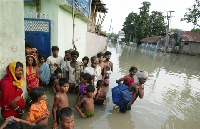India/Bangladesh
More troops sent to rescue flood victims
Article published on the 2008-09-01 Latest update 2008-09-01 09:21 TU
A disaster management official in Madhepura, in the state of Bihar says that more than half a million people have been evacuated from the flood disaster zone.
Extra Indian army and navy troops have been sent in to reach several hundred thousand more stranded by the flooding, many without food and drinking water for days.
But aid agency, Action Aid says the State government should have been better prepared, as the region is hit by monsoon rains every year. "A long-term comprehensive response is necessary," says the NGO.
A United Nations childrens' agency specialist is warning of the spread of disease, especially as it's likely that the flood waters will take time to drain. The Unicef emergency expert in the region, expects it will take at least three months, and therefore it's urgent to vaccinate people quickly.
More than seventy people have lost their lives in the floods, which have swamped hundreds of villages.
In Nepal, where the river Kosi overflowed and changed course two weeks ago, causing the flooding in Bihar State, more than 50,000 people have been displaced. They have found shelter in government buildings, schools and temporary camps. The Nepalese authorities say that work is underway to repair the damaged embankments and prevent further flooding.
Meanwhile, in India's eastern neighbour, Bangladesh, at least 72,000 people are reported marooned due to flooding after two rivers in the north and the centre of the country burst their banks.
Officials at the national Flood Forecasting Centre warned that three main rivers in the country are rising fast. They say that the Ganges and the Brahamputra have already crossed danger levels due to heavy rains and the fast flowing water from India. The Meghna is also at risk of overflowing.
Last year, in Bangladesh, season flooding in July and August left more than 1,000 people dead and about 40 per cent of the country under water, forcing millions to leave their homes.






